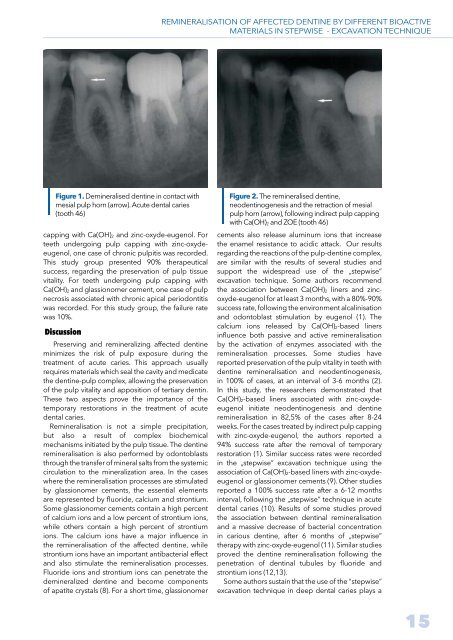STOMATOLOGY EDU JOURNAL 1-2014
You also want an ePaper? Increase the reach of your titles
YUMPU automatically turns print PDFs into web optimized ePapers that Google loves.
REMINERALISATION OF AFFECTED DENTINE BY DIFFERENT BIOACTIVE<br />
MATERIALS IN STEPWISE - EXCAVATION TECHNIQUE<br />
Figure 1. Demineralised dentine in contact with<br />
mesial pulp horn (arrow). Acute dental caries<br />
(tooth 46)<br />
capping with Ca(OH) 2 and zinc-oxyde-eugenol. For<br />
teeth undergoing pulp capping with zinc-oxydeeugenol,<br />
one case of chronic pulpitis was recorded.<br />
This study group presented 90% therapeutical<br />
success, regarding the preservation of pulp tissue<br />
vitality. For teeth undergoing pulp capping with<br />
Ca(OH) 2 and glassionomer cement, one case of pulp<br />
necrosis associated with chronic apical periodontitis<br />
was recorded. For this study group, the failure rate<br />
was 10%.<br />
Discussion<br />
Preserving and remineralizing affected dentine<br />
minimizes the risk of pulp exposure during the<br />
treatment of acute caries. This approach usually<br />
requires materials which seal the cavity and medicate<br />
the dentine-pulp complex, allowing the preservation<br />
of the pulp vitality and apposition of tertiary dentin.<br />
These two aspects prove the importance of the<br />
temporary restorations in the treatment of acute<br />
dental caries.<br />
Remineralisation is not a simple precipitation,<br />
but also a result of complex biochemical<br />
mechanisms initiated by the pulp tissue. The dentine<br />
remineralisation is also performed by odontoblasts<br />
through the transfer of mineral salts from the systemic<br />
circulation to the mineralization area. In the cases<br />
where the remineralisation processes are stimulated<br />
by glassionomer cements, the essential elements<br />
are represented by fluoride, calcium and strontium.<br />
Some glassionomer cements contain a high percent<br />
of calcium ions and a low percent of strontium ions,<br />
while others contain a high percent of strontium<br />
ions. The calcium ions have a major influence in<br />
the remineralisation of the affected dentine, while<br />
strontium ions have an important antibacterial effect<br />
and also stimulate the remineralisation processes.<br />
Fluoride ions and strontium ions can penetrate the<br />
demineralized dentine and become components<br />
of apatite crystals (8). For a short time, glassionomer<br />
Figure 2. The remineralised dentine,<br />
neodentinogenesis and the retraction of mesial<br />
pulp horn (arrow), following indirect pulp capping<br />
with Ca(OH) 2 and ZOE (tooth 46)<br />
cements also release aluminum ions that increase<br />
the enamel resistance to acidic attack. Our results<br />
regarding the reactions of the pulp-dentine complex,<br />
are similar with the results of several studies and<br />
support the widespread use of the „stepwise”<br />
excavation technique. Some authors recommend<br />
the association between Ca(OH) 2 liners and zincoxyde-eugenol<br />
for at least 3 months, with a 80%-90%<br />
success rate, following the environment alcalinisation<br />
and odontoblast stimulation by eugenol (1). The<br />
calcium ions released by Ca(OH) 2-based liners<br />
influence both passive and active remineralisation<br />
by the activation of enzymes associated with the<br />
remineralisation processes. Some studies have<br />
reported preservation of the pulp vitality in teeth with<br />
dentine remineralisation and neodentinogenesis,<br />
in 100% of cases, at an interval of 3-6 months (2).<br />
In this study, the researchers demonstrated that<br />
Ca(OH) 2-based liners associated with zinc-oxydeeugenol<br />
initiate neodentinogenesis and dentine<br />
remineralisation in 82,5% of the cases after 8-24<br />
weeks. For the cases treated by indirect pulp capping<br />
with zinc-oxyde-eugenol, the authors reported a<br />
94% success rate after the removal of temporary<br />
restoration (1). Similar success rates were recorded<br />
in the „stepwise” excavation technique using the<br />
association of Ca(OH) 2-based liners with zinc-oxydeeugenol<br />
or glassionomer cements (9). Other studies<br />
reported a 100% success rate after a 6-12 months<br />
interval, following the „stepwise” technique in acute<br />
dental caries (10). Results of some studies proved<br />
the association between dentinal remineralisation<br />
and a massive decrease of bacterial concentration<br />
in carious dentine, after 6 months of „stepwise”<br />
therapy with zinc-oxyde-eugenol (11). Similar studies<br />
proved the dentine remineralisation following the<br />
penetration of dentinal tubules by fluoride and<br />
strontium ions (12,13).<br />
Some authors sustain that the use of the “stepwise”<br />
excavation technique in deep dental caries plays a<br />
15



